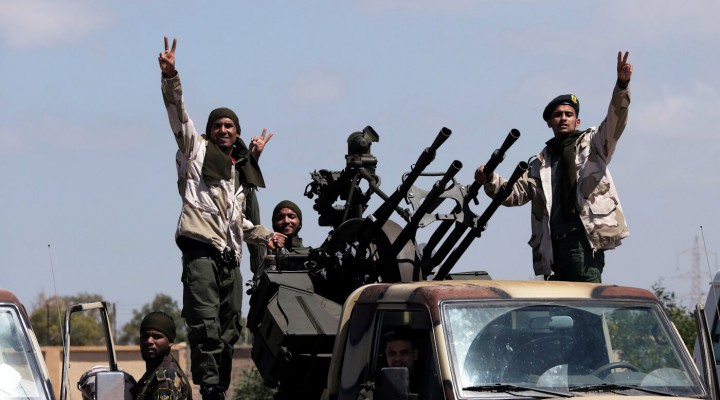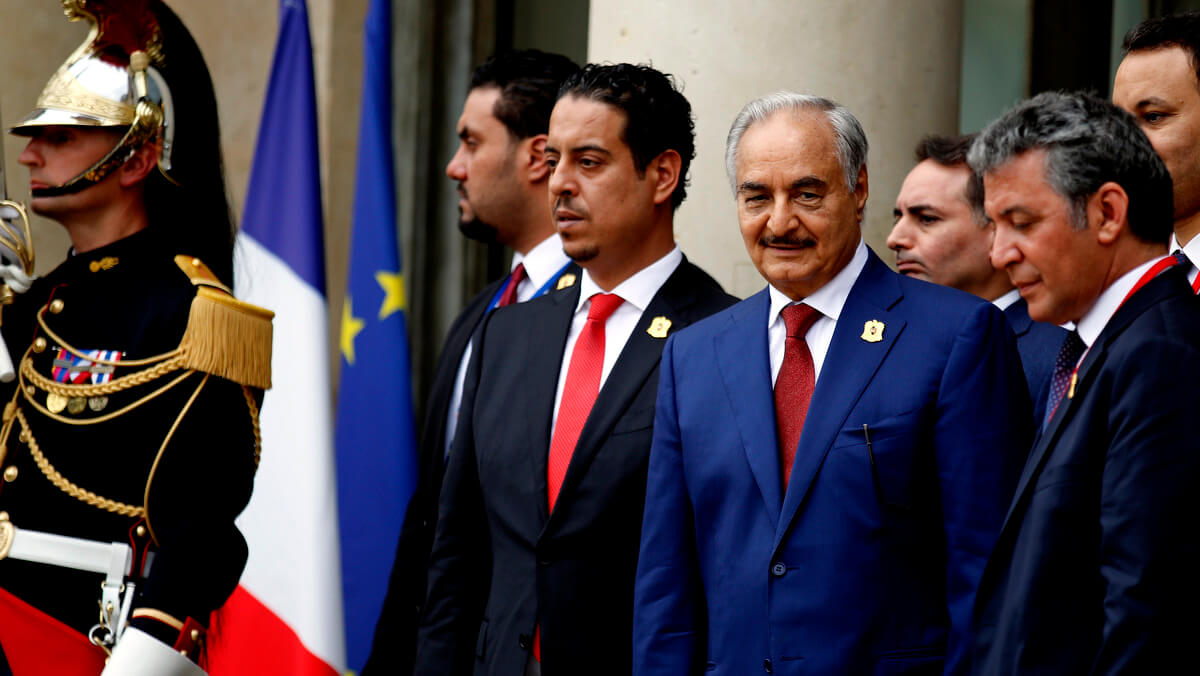Libya Risks Being Torn to Shreds — Again — by Former CIA Asset Turned Warlord

MPN- Already, the usual suspects are clamoring for U.S. intervention as Haftar’s forces advance on the capital. With not just al-Qaeda, but now ISIS, a threat to stability in the country, the New York Times is calling on the Trump administration to “act fast.”
Libyan strongman Khalifa Haftar, a 40-year veteran of Libyan politics and longtime CIA asset, on Thursday ordered his self-styled Libyan National Army (NLA) to advance on the densely populated capital, Tripoli, where the United Nations-backed government is seated.
In the aftermath of the “humanitarian intervention” led by NATO in support of jihadists seeking to oust longtime leader Muammar Gaddafi in 2011, various factions have vied for power in the war-torn nation, once the wealthiest in Africa. According to the Special Monitoring Mission to Libya, forces loyal to Haftar, a former CIA asset, now control more than 77 percent of the country.
Here is one more map on who controls what in Libya by the end of March, 2019.
Libyan National Army – 1,256,987 km2 – approx. 77,5%
Government of National Accord – 105,894 km2 – approx. 6,5%
Areas near the southern border (marked by blue marine) are in control of Tubou pic.twitter.com/jowq2J7k7D
— SMM Libya (@smmlibya) April 1, 2019
The situation in and around Tripoli was fluid through the weekend with at least 25 killed and 80 wounded, according to the country’s health ministry. U.S. military personnel have evacuated, as have some 2,800 civilians, according to the United Nations.
Haftar had addressed his forces, ironically ordering them to advance on Tripoli in order to free it from “militias and terrorists.” He vowed not to kill foreigners or civilians, but only those who “prefer confrontation and fighting.”
“We are coming, Tripoli, we are coming,” he said.
That was shortly after his troops captured the town of Gharyan, which is just 62 miles (100km) from the capital. The following day, , AFP reported that Haftar’s troops were expelled from a “key checkpoint” just 16 miles (27km) from Tripoli. Reportedly, some 130 fighters loyal to Haftar were taken prisoner. The outlet quotes a spokesperson for the NLA as saying:
There will be other hubs that will be opened within the next hours for the advancement towards Tripoli from multiple sides and places. Large forces have now been set out; approximately two teams, light infantry and mechanized infantry.”
On the brink — again?
Observers fear that the confrontation will escalate into a full-scale civil war in the nation, which is still reeling from the NATO-backed intervention. Haftar’s announcement of an advance on Tripoli came as the UN Secretary-General Antonio Guterres was wrapping up a peace-brokering mission in the country, in which he met with Haftar as well as the UN-backed prime minister, Fayez al-Serraj.
“I leave Libya with a heavy heart and deeply concerned. I still hope it is possible to avoid a bloody confrontation in and around Tripoli,” Guterres lamented. The developments also come ahead of UN-brokered peace talks slated for April 14-16. On Friday, the UN Security Council held an emergency meeting on the situation.
I leave Libya with a heavy heart and deeply concerned. I still hope it is possible to avoid a bloody confrontation in and around Tripoli.
The UN is committed to facilitating a political solution and, whatever happens, the UN is committed to supporting the Libyan people.
— António Guterres (@antonioguterres) April 5, 2019
I am deeply concerned by the military movement taking place in Libya and the risk of confrontation. There is no military solution. Only intra-Libyan dialogue can solve Libyan problems. I call for calm and restraint as I prepare to meet the Libyan leaders in the country.
— António Guterres (@antonioguterres) April 4, 2019
The UN-backed government shows no signs of holding out for the peace talks. Prime Minister al-Sarraj reportedly ordered his military to be prepared for combat and gave the green light for airstrikes in a bid to “defend the civilian population and crucial facilities,” Tass reports.
Who is Haftar?
Haftar recently told an Arabic-language newspaper that “Libyans will have a single cabinet this month,” RT reported, noting that should Haftar take power, he would control the largest oil reserves in Africa, although he already controls many oil fields. Haftar’s ambition to rule is decades old. He was among a group of officers responsible for the coup that installed Gadaffi in 1969. After being taken prisoner by Chad in 1987 while working for Gaddafi, Haftar turned his back on the leader.

Khalifa Haftar, third left, leaves after an International Conference on Libya at the Elysee Palace, in Paris, France May 29, 2018. Francois Mori | AP
After his release, which was secured with U.S. assistance, Haftar joined the National Front for the Salvation of Libya, an opposition group supported by the CIA, to prepare an army that could overthrow Gaddafi. According to officials cited in a 1991 New York Times report, Haftar’s men were “trained” by “American intelligence officials in sabotage and other guerilla skills.”. He was eventually flown to Langley, Virginia — where the CIA is headquartered — and lived there for two decades, working with the CIA to topple the Libyan leader from abroad. He and 350 fighters loyal to him were admitted into the U.S. and given refugee status.
In 1996, Haftar went back to Libya and again attempted to depose the leader.
But by the time Gaddafi was ousted in 2011, Haftar had fallen into obscurity. Then, in 2014, as the local al-Qaeda affiliate Ansar al-Sharia was occupying Benghazi, Libya’s second largest city, Haftar announced his return on Libyan television. He then launched Operation Dignity, which ousted the Islamists from Benghazi. In 2016. Haftar launched Operation Swift Thunder, which took control of key positions in the “oil crescent” from the UN-backed government.
The following year, Haftar banned women under the age of 60 from traveling alone in areas under his control.
Already, the usual suspects are clamoring for U.S. intervention as Haftar’s forces advance on the capital. With not just al-Qaeda, but now ISIS, a threat to stability in the country, the New York Times is calling on the Trump administration to “act fast.”
But it was U.S. involvement in the Middle East and North Africa that led to the wholesale destruction of Iraq and Syria, and produced figures like the CIA-trained Hafter in the first place. U.S. involvement in Libya, in particular, led to black Africans being sold as slaves in open-air markets and to the refugee crisis inflaming the ultra-right in Europe.
Libya Risks Being Torn to Shreds — Again — by Former CIA Asset Turned Warlord
 TheAltWorld
TheAltWorld 
0 thoughts on “Libya Risks Being Torn to Shreds — Again — by Former CIA Asset Turned Warlord”